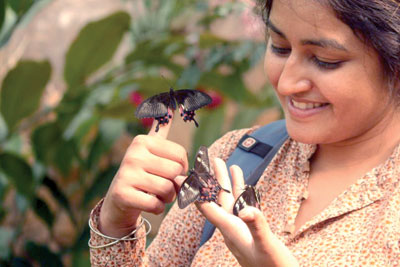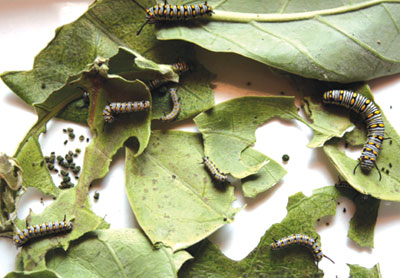- Home
- Archive -Mar 2013
- Madam Butterfly

Madam Butterfly
- In :
- Personal Growth
March 2013
by Shivi Verma
Anupreet Kaur Dhody rears butterflies for a hobby and then sets them free, a small act that adds beauty and color to our world, says Shivi Verma
 |
Rearing butterflies? Who does that? Meet Anupreet Kaur Dhody, a former stock broker, who lives in Bangalore with her software professional husband Rajesh Golani, and spends her spare time growing plants that attract butterflies, collecting their eggs, feeding the larvae, housing the pupa and finally when the butterfly makes its stunning appearance, holding it in her hand for it to dry its wings before essaying its flight to freedom and life. “There is no special reason for it, I do it because I love doing it,” she says.
The windows of her two-bedroom flat are a riot of color as flocks of butterflies flit around to suck nectar from flowering plants. “I have to be careful. Not all flowering plants are butterfly-friendly, therefore I study and grow only those flowers that attract the butterflies,” says the dedicated butterfly lady.
What was the inspiration behind this enchanting practice? Like most of our deepest callings, it had its root in childhood. She says, “When I was six years old, I was returning from a holiday with my family, and was standing on the platform waiting for the train. My father, in the meantime, searched under every leaf of plants present over there and found a caterpillar of a butterfly. He gifted it to me. I brought it home, put it in a box under my father’s supervision, and to my delight saw it turning into a pupa and subsequently into a beautiful butterfly after a few days. The day the butterfly came out; I missed school out of joy.”
Soon Anupreet forgot that bright glow of joy, and went about her life, growing, studying, graduating, and making a career in high finance in Mumbai.
In 2010, her love for nature made her join the Bombay Natural History Society where she met Dr Usha Desai, a retired doctor and entomologist, who conducts tree walks regularly around town. She collects nature lovers, selects a garden and teaches them how to identify trees and plants.
“Three months after my wedding in the year 2011 she gifted me a pupa,” recalls Anupreet. “The emergence of the butterfly rekindled my fondness for these beautiful creatures. By that time, I had started growing food on my terrace and butterflies had begun to visit them. I noticed that plants like ajwain, coriander, and fennel attracted butterflies. In my enthusiasm, I planted more flowers.
| ‘I searched the internet and found that not every flower is suitable for butterflies. Only those flowers that have an accessible center of nectar will draw butterflies.’ | ||
To my dismay I saw that butterflies steered clear of them. To know more, I searched the internet and found that not every flower is suitable for butterflies. Only those flowers that have an accessible center of nectar will draw butterflies, such as the sunflower, mustard flower, coriander flowers. Not only that, the plant a butterfly feeds on may or may not be the same she will lay her eggs on. The host plants will be different. This is where Dr Usha’s knowledge of plants came handy to me. She gifted me a leaf of bryophyllum plant and asked me to plant it in a pot. Soon tiny independent plants were coming out of the edges of the leaf. I was delighted to notice a tiny cluster of butterfly eggs on them, one fine day.”
Anupreet began to study more to invite butterflies to lay eggs. She read about host plants and began to sow plants such as bryophyllum, lime, curry leaf, hollyhocks, and hibiscus, which were suitable hosts for butterfly eggs and for caterpillars to feed on. To provide nectar, she planted flowers such as pentas, Jamaicas, and cosmos. Her efforts paid off and butterflies soon began to flock.
Happily, she noticed that they had even begun to lay eggs. When caterpillars appeared, the concern to protect them from predators arose. “A caterpillar has many enemies. Birds, squirrels, and ants prey on them. So in order to protect them, I placed them in transparent boxes, with their food leaves, a small stick, and pierced holes on top of the box for air to pass through. To my surprise, I saw ants finding their way up to the box and eating up the larvae. In time I found that the larvae did not need much air. So I began to put them in closed boxes and opened them occasionally for a whiff of fresh air.” Normally, a caterpillar eats ravenously for eight to 10 days at a stretch. She mindfully keeps the boxes filled with their food, usually green leaves, until they pupate. “One day I saw the color of a pupa turn dark. I thought that something had gone wrong. But soon the cocoon cracked open and a beautiful butterfly came out.
 |
‘I took it on my finger and let her dry her wings. It is one of the most magical experiences to see a butterfly trustingly crawl over your fingers. Generally butterflies hide under the leaves of plants to pump blood to their veins, putting themselves at great risk of being devoured by predators. Now I lend them a thread and they hang from it until they are strong and dry enough to take flight. It is sheer joy,” she exults.
Anupreet rears more than hundred butterflies every month. “I set them free. I never cage or imprison them. Many people have approached me asking me to lend them butterflies for making a butterfly box, but I turn them down.
“In my locality, I quietly go and disperse seeds of plants that attract butterflies. The use of pesticides by farmers is a big reason for the reduction of butterflies. Cabbage is highly suitable for a caterpillar’s growth, but the spray of insecticides kills them en masse,” she mourns. Anupreet also conducts workshops for children on the art of rearing butterflies.
“Kids learn to identify different species of butterflies and plants and trees. It ignites their interest for delicate things in nature,” she says.
A nature lover, Anupreet also does organic farming on the terrace of her building. “The vegetables I grow are much healthier and bigger than the ones purchased from the market. If all of us begin to grow our own vegetables, we can become self-reliant in this respect and also regain our health,” she opines.
Currently on a sabbatical from her job as a stock broker, she has no intention of resuming it any time soon. “I am too happy in my current occupation of rearing butterflies,” she says, her eyes shining with the joy of doing something truly worthwhile.
In a world where the pursuit of wealth and success is considered the route to happiness, here is someone who has found an authentic path to it, simply by adding beauty to the world instead of detracting from it.
To read more such articles on personal growth, inspirations and positivity, subscribe to our digital magazine at subscribe here
Life Positive follows a stringent review publishing mechanism. Every review received undergoes -
- 1. A mobile number and email ID verification check
- 2. Analysis by our seeker happiness team to double check for authenticity
- 3. Cross-checking, if required, by speaking to the seeker posting the review
Only after we're satisfied about the authenticity of a review is it allowed to go live on our website
Our award winning customer care team is available from 9 a.m to 9 p.m everyday
The Life Positive seal of trust implies:-
-
Standards guarantee:
All our healers and therapists undergo training and/or certification from authorized bodies before becoming professionals. They have a minimum professional experience of one year
-
Genuineness guarantee:
All our healers and therapists are genuinely passionate about doing service. They do their very best to help seekers (patients) live better lives.
-
Payment security:
All payments made to our healers are secure up to the point wherein if any session is paid for, it will be honoured dutifully and delivered promptly
-
Anonymity guarantee:
Every seekers (patients) details will always remain 100% confidential and will never be disclosed
